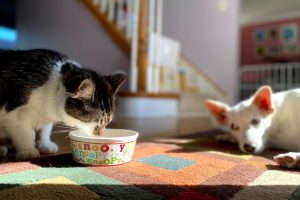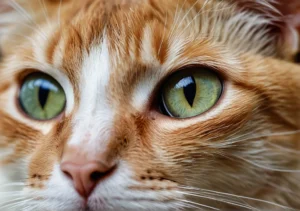Cats are known for their mesmerizing eyes. Have you ever noticed why their eyes sometimes appear larger than usual? Let’s explore the reasons behind this intriguing feline characteristic.
Natural Adaptation to Low Light Conditions
Cats’ eyes are big sometimes as a remarkable evolutionary adaptation to low light conditions. These larger pupils allow more light to enter the eye, aiding in maximizing light absorption and enhancing their vision in the dark. In dimly lit environments, cats’ eyes can dilate up to three times their normal size, allowing them to see clearly even in minimal lighting. This feature gives them a competitive edge when hunting at night, as they can detect movement and track prey with precision. So, next time you catch your feline friend with big, round eyes, remember that it’s all part of their natural design to navigate the dark with ease.
Communication Through Pupil Dilation
Have you ever noticed your cat’s pupils expanding when they’re excited, scared, or trying to show affection? This is because cats use their enlarged pupils not only to see better in low light but also to communicate their emotions and intentions to other cats and humans. When a cat is feeling threatened or anxious, their pupils dilate to make them appear larger and more intimidating. On the other hand, when they’re feeling playful or content, their pupils may constrict into tiny slits. Understanding this non-verbal form of communication can help you connect with your feline companion on a deeper level and respond to their needs accordingly.
- Interest and Curiosity: When a cat is intrigued by something, their pupils will dilate to take in more information. If you notice your cat with big eyes while gazing at a bird or a toy, they’re likely showing their keen interest in the object.
- Fear and Stress: In stressful situations, a cat’s pupils may dilate to signal their discomfort or fear. If you see your cat with large pupils in response to a loud noise or unfamiliar environment, they may be feeling anxious and in need of reassurance.
By being attuned to your cat’s body language, especially their pupil size, you can better understand how they’re feeling and respond accordingly to ensure their well-being and comfort.
Sign of Alertness and Curiosity
Hey, ever noticed how your cat’s eyes seem to get big when they’re super alert or curious? It’s not just for show – those big peepers are actually a sign that your feline friend is fully engaged with their surroundings. When a cat’s eyes are large and round, it means they’re on high alert, ready to pounce on any unexpected movement or noise. It’s their way of staying sharp and ready for action. So next time you see those big eyes, know that your cat is completely tuned in and focused on what’s happening around them.
Health Indicators
Did you know that changes in the size of your cat’s eyes can actually be a sign of potential health issues? Yeah, it’s not just about cuteness – those peepers can tell you a lot about your furry friend’s well-being. If you notice your cat’s eyes suddenly getting bigger or smaller than usual, it could be a sign of pain, stress, or even an underlying health condition that needs attention. Keep an eye out for any unusual changes in their eye size, as it could be your cat’s way of communicating that something’s not quite right. Remember, your cat’s eyes are more than just windows to their soul – they can also be important indicators of their overall health. So pay attention and check in with your vet if you notice anything out of the ordinary.
Playfulness and Prowess
Have you ever noticed that a cat’s eyes can seem especially large when they’re in a playful mood or on the hunt? It’s not just for show – those big eyes serve a purpose. When a cat is feeling playful, their large pupils allow more light to enter the eyes, helping them see better in dim lighting. This enhanced vision comes in handy during their hunting escapades, giving them the edge they need to catch their prey with precision.
Additionally, a cat’s dilated pupils can signal excitement and readiness to pounce, making them more agile and quick on their feet. So, next time you catch your feline friend with big, wide eyes during playtime, know that it’s a sign of their natural hunting instincts kicking in. Embrace their wild side and watch them conquer their toys with finesse!
Extra tip: Providing plenty of toys and interactive play sessions can help satisfy your cat’s natural instincts and keep them mentally and physically stimulated.
Unique Eye Structures
Did you know that a cat’s eye anatomy is truly fascinating? Their eyes have a specialized structure that allows them to change pupil size rapidly, making them incredibly adaptable hunters. Cats have slit-like pupils that can expand to almost full circles in low light, maximizing their ability to see in the dark.
Moreover, cats have a reflective layer behind their retina called the tapetum lucidum, which enhances their night vision by reflecting light back through their eyes. This unique feature explains why a cat’s eyes may appear to glow in the dark – it’s all part of their impressive design for nocturnal activities.
Next time you marvel at your cat’s mesmerizing eyes, remember that their intricate eye structures play a crucial role in their hunting prowess and survival instincts, making them the skilled predators they are.
Extra tip: Regular veterinary check-ups can help ensure your cat’s eyes are healthy and functioning optimally. Check with your vet if you notice any changes in their eye appearance or behavior.
Cat Eye Myths Debunked
Do cats see in complete darkness? Are they colorblind? Let’s debunk some common myths about cat eyes:
Cats can see in complete darkness : While cats have excellent night vision, they can’t see in total darkness. They need some light to see effectively.
Cats are colorblind : Contrary to popular belief, cats are not entirely colorblind. They can see some colors, just not as vividly as humans do.
Cats always have big pupils : Cats’ pupils dilate and constrict based on light levels and their emotions. So, big pupils don’t indicate size, but often suggest arousal or curiosity.
Cats’ eyes reflect light for night vision : While cats’ eyes do reflect light, aiding in night vision, this isn’t the sole reason for their exceptional vision in the dark.
Cats see well in the dark due to their eye structure : Cats have large corneas and elliptical pupils that let in more light, enhancing their night vision capabilities.
Cats have better vision than humans : While cats do have superior night vision, humans have better color perception and clarity during the day.
Remember, cats’ eyes are fascinating, but understanding the truth behind these myths can help you appreciate their unique vision even more.
Interesting Facts About Cat Eyes
Curious about what makes cat eyes so captivating? Here are some interesting facts you may not know:
Tapetum Lucidum : Cats have a reflective layer called the tapetum lucidum behind their retina, which helps amplify light in their eyes, allowing them to see better in low light.
Wider Field of View : Cats have a wider field of view than humans, about 200 degrees compared to our 180 degrees. This helps them detect movement and potential prey more easily.
Vertical Pupils : The vertical shape of a cat’s pupils can expand up to five times their normal size to let in more light. This unique design helps cats in hunting during the low-light hours of dawn and dusk.
Nocturnal Hunters : Due to their eye structure and adaptations, cats are more active during dusk and dawn when their vision is optimized for hunting.
Blind Spot : Cats have a blind spot right in front of their nose. That’s why they sometimes seem unfocused when an object is too close to their face.
Understanding these fascinating facts can deepen your appreciation for the incredible nature of cat eyes.
Alex, a passionate animal lover, has experience in training and understanding animal behavior. As a proud pet parent to two dogs and three cats, he founded AnimalReport.net to share insights from animal experts and expand his knowledge of the animal kingdom.




